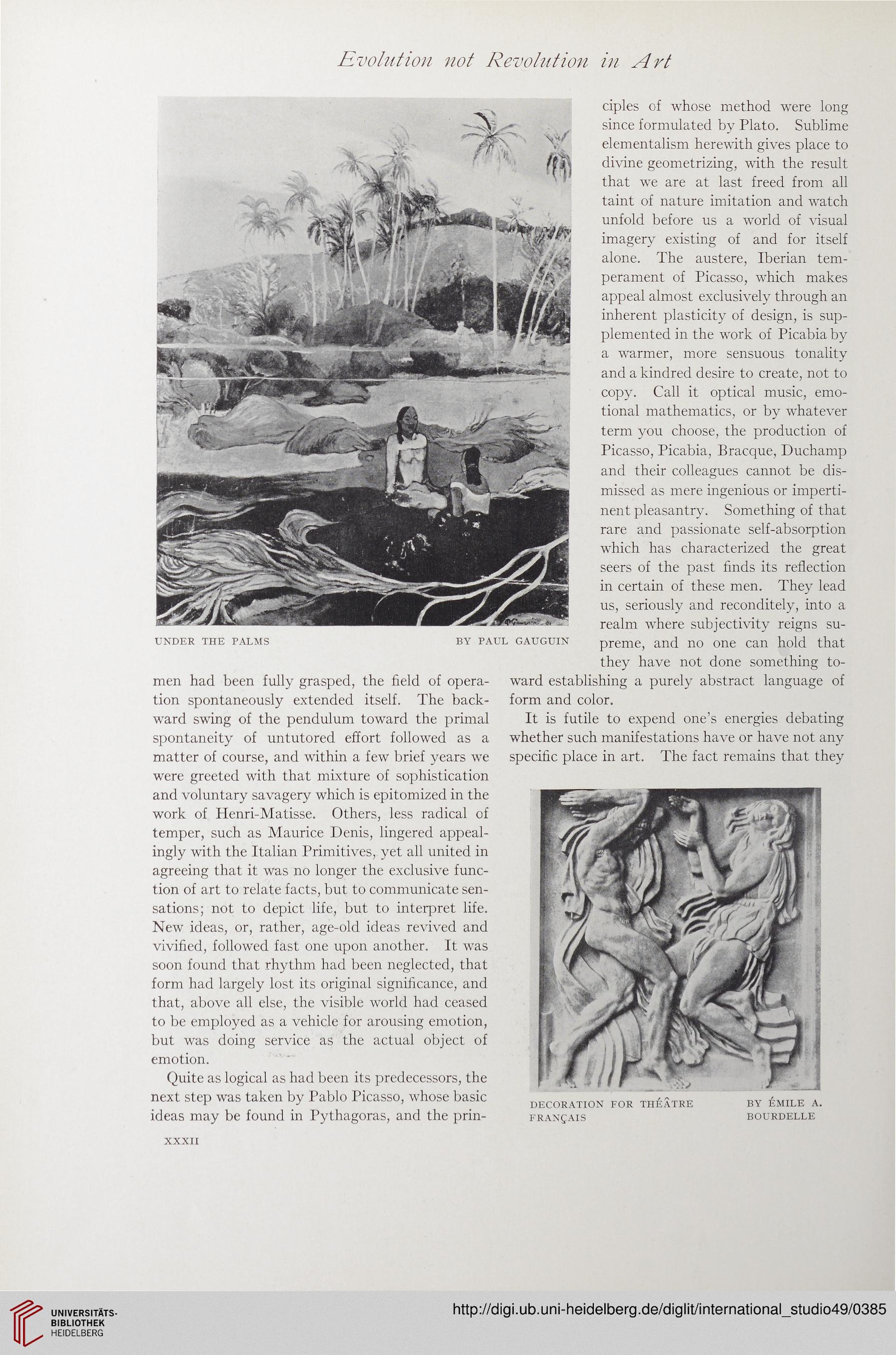Evolution not Revolution in Art
BY PAUL GAUGUIN
UNDER THE PALMS
men had been fully grasped, the field of opera-
tion spontaneously extended itself. The back-
ward swing of the pendulum toward the primal
spontaneity of untutored effort followed as a
matter of course, and within a few brief years we
were greeted with that mixture of sophistication
and voluntary savagery which is epitomized in the
work of Henri-Matisse. Others, less radical of
temper, such as Maurice Denis, lingered appeal-
ingly with the Italian Primitives, yet all united in
agreeing that it was no longer the exclusive func-
tion of art to relate facts, but to communicate sen-
sations; not to depict life, but to interpret life.
New ideas, or, rather, age-old ideas revived and
vivified, followed fast one upon another. It was
soon found that rhythm had been neglected, that
form had largely lost its original significance, and
that, above all else, the visible world had ceased
to be employed as a vehicle for arousing emotion,
but was doing service as the actual object of
emotion.
Quite as logical as had been its predecessors, the
next step was taken by Pablo Picasso, whose basic
ideas may be found in Pythagoras, and the prin-
ciples of whose method were long
since formulated by Plato. Sublime
elementalism herewith gives place to
divine geometrizing, with the result
that we are at last freed from all
taint of nature imitation and watch
unfold before us a world of visual
imagery existing of and for itself
alone. The austere, Iberian tem-
perament of Picasso, which makes
appeal almost exclusively through an
inherent plasticity of design, is sup-
plemented in the work of Picabia by
a warmer, more sensuous tonality
and a kindred desire to create, not to
copy. Call it optical music, emo-
tional mathematics, or by whatever
term you choose, the production of
Picasso, Picabia, Bracque, Duchamp
and their colleagues cannot be dis-
missed as mere ingenious or imperti-
nent pleasantry. Something of that
rare and passionate self-absorption
which has characterized the great
seers of the past finds its reflection
in certain of these men. They lead
us, seriously and reconditely, into a
realm where subjectivity reigns su-
preme, and no one can hold that
they have not done something to¬
ward establishing a purely abstract language of
form and color.
It is futile to expend one’s energies debating
whether such manifestations have or have not any
specific place in art. The fact remains that they
DECORATION FOR THEATRE BY EMILE A.
FRANQAIS BOURDELLE
XXXII
BY PAUL GAUGUIN
UNDER THE PALMS
men had been fully grasped, the field of opera-
tion spontaneously extended itself. The back-
ward swing of the pendulum toward the primal
spontaneity of untutored effort followed as a
matter of course, and within a few brief years we
were greeted with that mixture of sophistication
and voluntary savagery which is epitomized in the
work of Henri-Matisse. Others, less radical of
temper, such as Maurice Denis, lingered appeal-
ingly with the Italian Primitives, yet all united in
agreeing that it was no longer the exclusive func-
tion of art to relate facts, but to communicate sen-
sations; not to depict life, but to interpret life.
New ideas, or, rather, age-old ideas revived and
vivified, followed fast one upon another. It was
soon found that rhythm had been neglected, that
form had largely lost its original significance, and
that, above all else, the visible world had ceased
to be employed as a vehicle for arousing emotion,
but was doing service as the actual object of
emotion.
Quite as logical as had been its predecessors, the
next step was taken by Pablo Picasso, whose basic
ideas may be found in Pythagoras, and the prin-
ciples of whose method were long
since formulated by Plato. Sublime
elementalism herewith gives place to
divine geometrizing, with the result
that we are at last freed from all
taint of nature imitation and watch
unfold before us a world of visual
imagery existing of and for itself
alone. The austere, Iberian tem-
perament of Picasso, which makes
appeal almost exclusively through an
inherent plasticity of design, is sup-
plemented in the work of Picabia by
a warmer, more sensuous tonality
and a kindred desire to create, not to
copy. Call it optical music, emo-
tional mathematics, or by whatever
term you choose, the production of
Picasso, Picabia, Bracque, Duchamp
and their colleagues cannot be dis-
missed as mere ingenious or imperti-
nent pleasantry. Something of that
rare and passionate self-absorption
which has characterized the great
seers of the past finds its reflection
in certain of these men. They lead
us, seriously and reconditely, into a
realm where subjectivity reigns su-
preme, and no one can hold that
they have not done something to¬
ward establishing a purely abstract language of
form and color.
It is futile to expend one’s energies debating
whether such manifestations have or have not any
specific place in art. The fact remains that they
DECORATION FOR THEATRE BY EMILE A.
FRANQAIS BOURDELLE
XXXII




